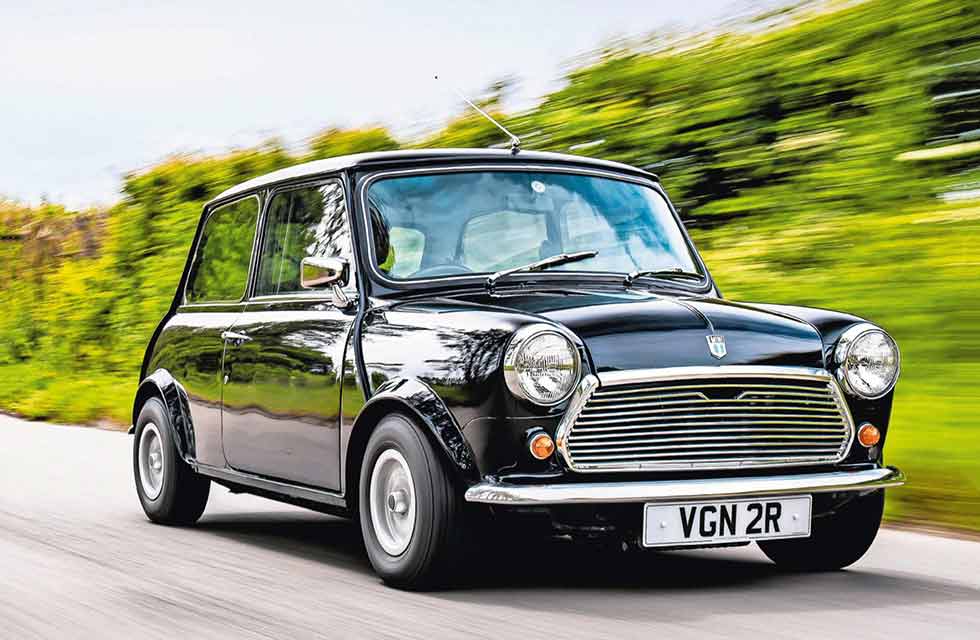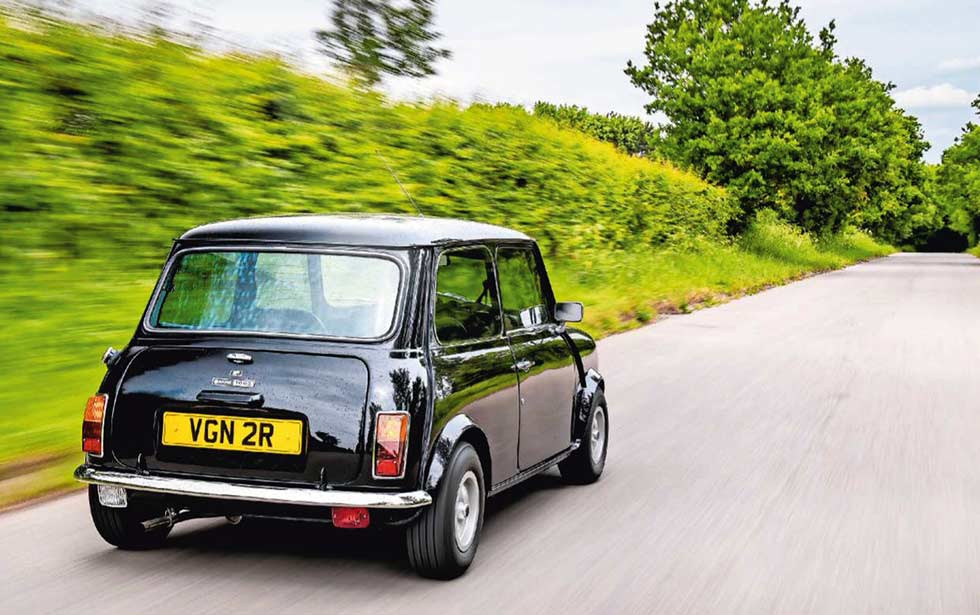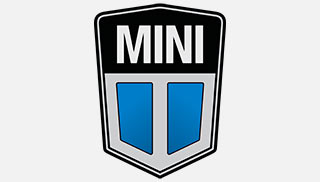
The early Sixties saw celebrities start a craze for sending their laugh-a-minute Minis to a coachbuilder for some luxury personalisation. Cilla Black‘s 1977 car was given a £3000 makeover by Wood & Pickett – and today we’re taking it for a drive. Words Ivan Ostroff. Photography Johnny Fleetwood.
Cruising London in Cilla Black’s Wood & Pickett Mini 1000
A LORRA LAUGHS
When she became a pop star, Priscilla White adopted a new stage moniker that would become a household name – Cilla Black. So it’s appropriate that the coachbuilt Mini she took delivery of on 2 May 1977 underwent the very same transformation, leaving the factory white but being repainted black during its immediate Wood & Pickett makeover.

Cilla’s new car, a Mini MkIV 1000 Automatic, was ordered on her behalf by her husband and manager Robert Willis. The singer had used a Bentley for the past decade but wanted something less flamboyant to use as a shopping car and to run her young sons around. Today, I’m about to take a re-trimmed seat behind the leather-clad Moto-Lita and drive it.
‘It has all the advantages of the original Mini, but also feels truly special’
As I encounter the car for the first time, the lightly smoked windows complement its immaculate black paint and original set of Minilite wheels, now refurbished as part of a recent restoration. There’s a ‘WP’ badge on the bootlid, a period Tex door-mirror on the driver’s side, and extra security locks fitted on both doors at Cilla’s behest. Aluminium sill plates tell me that the car is from ‘Wood & Pickett Limited, Abbey Road, Park Royal, NW10’, and the car retains the registration plate it wore during Cilla’s ownership, VGN 2R.

During this time, many A-listers were driving so-called coachbuilt Minis. The first such example was created for singer Anita Harris by Hooper; she was soon joined by the likes of Peter Sellers, Johnny Speight and all of The Beatles, with whom Cilla was close friends. Around the same time Cilla’s car arrived, comedian Ronnie Corbett took delivery of his – a Clubman 1275GT registered VGN 10R. Within the world of coachbuilt Minis this W&P pair are often referred to as the two VirGiNs.
I slip into the sumptuous black leather adjustable Recaro seat and make myself comfortable. Recaro didn’t make rear seats for the Mini, so Wood and Pickett re-upholstered and re-covered the existing bench to match the chairs up front. They not only look good but are genuinely comfortable, and at 5” 7’, I find there’s more than enough legroom. Between the front seats is a central glovebox that forms an armrest, fitted with a hinge so it can be folded backwards. The 14-inch leather-rimmed Moto-Lita steering wheel is the original ordered with the car. Weird to think that Our Cilla sat here in this very seat, with her hands on this very wheel.
‘I’m able to freely charge into a corner, lift off, let the back jump out and then plant my foot’
Set in the bespoke Walnut dash panel, there are two main instruments in front of me, a 120mph speedo on the left and a 7000rpm tachometer on the right. I note the odometer reads just 41,756 miles and that the leather of the upper dashboard rail is double-stitched, giving an extra air of quality normally associated with Aston Martins. I twist the key and the four-cylinder A-series springs into urgent life. With my left foot on the footbrake, I slide the automatic gear selector into D and drive is taken up with a slight jolt. Acceleration is not exactly inspirational, but that’s to be expected from a basic 998cc engine driving through a power-sapping four-speed AP automatic gearbox and torque converter.

This example also has the weight of extra soundproofing and all the other additional Wood & Pickett luxuries to deal with. The automatic gearbox feels basic but I can select gears manually by moving the gear selector along its gate. There may not be anything particularly exciting about a standard four-cylinder A series but it’s a well-tried unit and this one runs perfectly. After a few miles it occurs to me how comfortable this Mini is to travel in, and how well insulated its occupants are. This is not your typical Mini buzz-box.
Despite the gearbox, I have immense fun enjoying the handling. On country B-roads, it really comes into its own and I can make progress as quickly as I could ever need. I’m able to freely charge into a corner, lift off, let the back jump out and then plant my foot, although I need to remember that there’s not the instantaneous power delivery of a manual ’box to drag it out the other side. However, with the engine right over the front wheels traction is excellent, and once I get the knack of it I realise that I can drop down a cog manually using the gear selector lever. The rack-and-pinion steering is a delight, informing me constantly what’s going on up front. It’s light, delicate and direct with no play. The car corners like a mechanised skateboard.
When Cilla owned the car, it had twin leading-shoe drum brakes with no servo assistance. The Mini’s tiny wheels dictate that any drum brakes confined within are going to be small too. Hard driving can leave them struggling so in order to make the car easier to drive in modern traffic, restorer Steve Burkinshaw fitted later 7.5inch Cooper S discs at the front. This endows the car with excellent stopping power, making the most of the relative lack of weight.
There is now also a vacuum servo and an appropriately larger master cylinder. This gives plenty of feel through the pedal; they are perfectly balanced and the modern pads bite eagerly. Wood & Pickett left the suspension in its standard configuration so, combined with the Mini’s ultra short 2040mm wheelbase, things get a little Sixties-bouncy when undulations or sleeping policemen are encountered, but it’s smooth enough when cruising on kinder surfaces. At 60mph the car is perfectly happily, the engine distantly spinning away at 4000rpm; it will also keep up with the rest of the throng at around 70-75mph but by that point it becomes more buzzy and busy. With a top speed of a little over 80mph this was never going to be a high-speed tourer.
But Cilla had her Bentley T2 for that. She wanted the Mini predominantly for the school run or dashes to the local shops in Denham or Gerrards Cross, where she kept her family home in England. Being small and easy to park as well as simple and relaxing to drive in automatic form, a Mini was ideal – and with the extra comfort of its full leather interior and other various luxurious Wood & Pickett appointments, VGN 2R was obviously the perfect choice.
Wood & Pickett had been founded when William Wood and Lesley Pickett quit their jobs at coachbuilder Hooper & Company to start their own business together in 1947. From humble beginnings working out of Wood’s dining room the pair eventually managed to rent premises in Abbey Road – not the Westminster street namechecked by The Beatles, but the stretch in Park Royal from which many other coachbuilders of note operated. Following the success of Radford’s Mini DeVille in 1963, Wood & Pickett decided that should also specialise in luxury uprated Minis and by 1966 had converted its first Mini. In 1967 Eddie Collins, Radford’s Irish-born head of marketing, followed the pair’s path to join Wood & Pickett. He soon became managing director and was responsible for taking the company into the next era, and with his dynamism, the Mini programme became more adventurous and successful.
Under Collins the company developed its own style, including such features as tinted windows, stylish wheel arch extensions and oblong headlamps. Its dashboards were considered superior to Radford’s and the detailing of its leather work was pre-eminent. At the time Cilla’s Mini was specced there were more than 100 basic choices on the seven-page options list, beyond which requests for engine swaps and further bespoke work were welcomed. A ‘Margrave Elite’ interior retrim cost £595; a two-tone respray £425.
The company went on to offer upgrades for the Range Rover, and was called on by BL to help devise the Vogue specification while taking on one-off and low-volume commissions, including one from Harold Radford to customise his Triumph 1300. After a move to a larger premises in Ruislip in 1980, it proposed the Rover SD1 Prestige, two takes on the new Metro – Plus and Laser – and variations of the MGB, Montego and TR7. When William Wood and Lesley Pickett left the company it was still successful with full order books, but because of the economic climate the banks were not prepared to continue financing as before. As a result the company went into receivership and was bought out by Henly’s Motor Group in 1986. In 1988 Eddie Collins, the driving force in the company, was unable to get on with the new management and resigned. His leaving effectively brought an end to Wood & Pickett’s operations.
Ten years ago, coachbuilt Mini specialist Steve Burkinshaw saw one of these cars for sale and realised that it was either the ex-Cilla Black car or the ex-Corbett car. Steve knew that Ronnie Corbett’s car had every conceivable bell and whistle, including electric windows and a sunroof. This one, fairly unusually, had neither, so he deduced it was Cilla’s. Having been offered it once before and not bought it, this time he was not going to let it get away. Steve restored VGN 2R over the last three years.
He’s keen to point out that as well as Hooper, Wood & Pickett and Radford, there were many other companies offering special bodied and modified Minis at the time, including Downton, Stewart & Ardern and even Broadspeed. ‘They were all good in their own particular ways and remind you of a time when you could break out of the mould and do something different,’ he says.
But restoring these unique little cars comes with its own set of challenges, as Steve knows only too well. ‘The wiring left much to be desired – at first I thought that I’d just need to rewire the dashboard, but it was so bad I ended up fitting a complete new loom. The problem was that when Wood & Pickett added the various electrics and instruments, it compromised the wiring and made the car unreliable. Wiring is quite an intricate job on these coachbuilt cars because there were so many different electrical options.
‘The headlamps fitted to this car in period by Wood & Pickett had a specially wide bezel, and I recognised them as being from an Vanden Plas Princess. The original ones were still with the car but They were getting tatty; luckily I was able to find a new pair.’
The carpets were a luxurious faux fur type of pile. Unfortunately that had long gone off the market so Steve has fitted black Wilton. ‘The biggest problem we had to overcome was that the leather required considerable effort to restore without making it look over-restored. I did not want it looking plastic or brand new; it was crucial to maintain the patina.
‘The steering wheel was in a shocking state, but I eventually managed to get it thoroughly clean. It took a lot of elbow grease but I got all those years of grime off it and then treated with leather food until it finally came back to looking as it does now. ‘Originally the car had two large and rather hideous reversing
lamps either side of the numberplate, which had since disappeared. I replaced them with a matching reversing lamp and rear fog lamp so the car looks right and is also safer.’
Driving the finished object, I can understand why Cilla would happily leave her Bentley parked up and take her Mini. While it still has all the inimitable advantages of the original car, including dependable handling in the wet or on snow, it’s also much more civilised and feels truly special. Cilla might not have requested any more power but it’s pleasant to drive, and in today’s traffic the automatic gearbox is a boon.
Other road users can’t help but react to VGN 2R; the subtle exterior modifications Cilla chose mean the car retains its classless character, and its charm is heightened by the Mini’s increasing scarcity on the road. Other drivers wave and perennially let you out at junctions; pedestrians point and smile. They might not be aware of it, but they’re looking at a little piece of pop history.
Exterior modifications to Cilla’s car included thick-bezel headlights, Minilite alloy wheels and subtle wheelarch flares. Body seams were left intact by W&P, unlike some of the coachbuilt Minis of the time. 998cc A-series was plenty for Cilla to shuttle her sons and shopping around suburbia. Margrave Elite dashboard was a £485 option. The second most creative Abbey Road in London W&P usually transformed more potent models. Our Cilla had a taste for Minis – here she’s seen in a standard car in the Sixties.
1977 Leyland Mini by Wood & Pickett
Engine Transversely-mounted BMC A-series 998cc straight-four, ohv, single SU 1½ inch carburetor
Max power 39bhp @ 4750rpm
Max torque 51lb ft @ 2000rpm
Transmission AP four-speed automatic, front-wheel drive
Steering Rack and pinion
Suspension
Front: independent, double wishbones, rubber cones, telescopic dampers
Rear: trailing radius arms, horizontal tubular struts, rubber cones, telescopic dampers
Brakes Discs front, drums rear
Weight 617kg (1360lb)
Performance 0-60mph: 18sec
Top speed: 81mph
Price new Approx £6300 CC
Price Guide £1400-£4850 (standard Mini MkIV) 2019 auction sale price £20,535
OWNING A COACHBUILT MINI
The current owner of VGN2R is Susan Dalgarno, whose husband Sandy bought the car for her shortly before the Goodwood Revival just a few months ago. Says Susan, ‘My husband Sandy has always loved Minis and actually had a Mini 850 when it was new. He’s a mechanic by trade and years ago built a Mini pick-up that he used to race, fitted a 1300cc engine from a Vanden Plas.
‘Sandy also has an Outspan Orange Mini as well as one or two normal variants, but this is the first coachbuilt one we’ve owned. When he spotted it for sale via Classic Car Auctions, we were particularly interested in its provenance and unusual specification.
‘Furthermore, the car was sold with a ticket to the Goodwood Revival to be included as a feature in the Mini 60th anniversary celebration, which of course was a wonderful experience.
‘Sandy bought it for me to use as an everyday car for the summer time. During the winter months while there is danger of corrosion from the salt on the road, it will be kept in the garage. We had planned to drive the car home to Scotland after we bought it but we were going on holiday soon after the auction so it wasn’t possible.
‘However, we have now been out in it quite a bit and it drives really well; the restoration has obviously been carried out to a high standard. The interior luxuries combined with the automatic gearbox makes it a really relaxing car to drive.’






